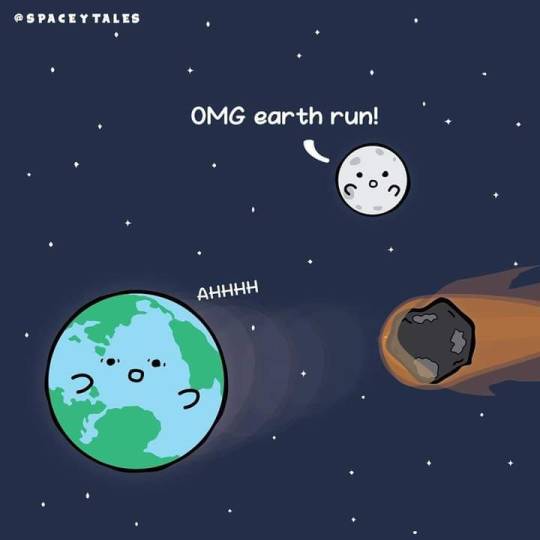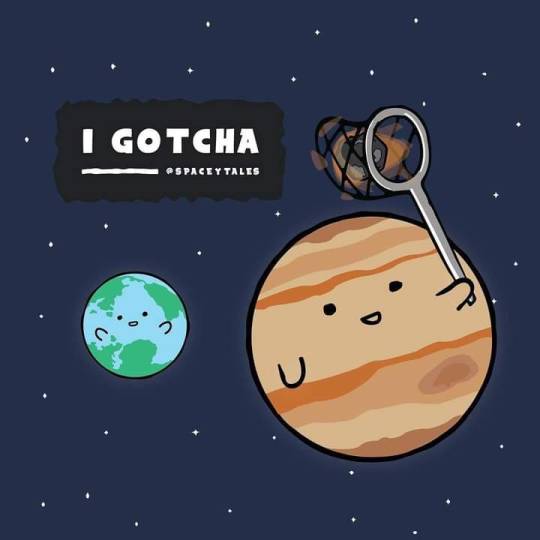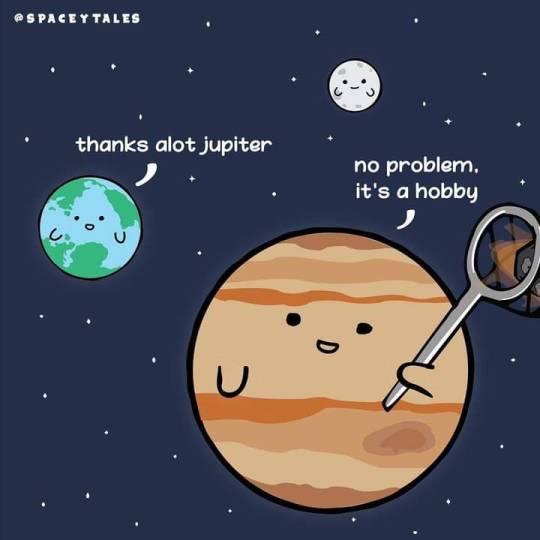Don't wanna be here? Send us removal request.
Text

APOD - PDS 70: Disk, Planets, and Moons
It's not the big disk that's attracting the most attention. Although the big planet-forming disk around the star PDS 70 is clearly imaged and itself quite interesting. It's also not the planet on the right, just inside the big disk, that’s being talked about the most. Although the planet PDS 70c is a newly formed and, interestingly, similar in size and mass to Jupiter. It's the fuzzy patch around the planet PDS 70c that's causing the commotion. That fuzzy patch is thought to be itself a dusty disk that is now forming into moons -- and that has never been seen before. The featured image was taken by the Atacama Large Millimeter Array (ALMA) of 66 radio telescopes in the high Atacama Desert of northern Chile. Based on ALMA data, astronomers infer that the moon-forming exoplanetary disk has a radius similar to our Earth's orbit, and may one day form three or so Luna-sized moons -- not very different from our Jupiter's four.
Date: 2021-08-25
#astronomy
8 notes
·
View notes
Text
youtube
A new video on TESS by me reveals triple-binary eclipsing star system & Sun-like star with extremely close exoplanets.
6 notes
·
View notes
Text

Magnetic field lines of the sun made by collapsing the details of the chromosphere into thinner linear features
Credit: @thevastreaches Check out the page for more info behind this image!
Data from Explore Scientific AR152, Daystar Quark Chromosphere, ASI174MM-Cool Celestron AVX, December 10, 2020, 1250/5000 stacked
22 notes
·
View notes
Photo

Planetary Migration
Mercury, Venus, Earth, Mars, Jupiter, Saturn .. You probably know what comes next, but .. what if I said Neptune, Uranus ?
The planets like the stars seem like clockwork, fixed in their specific orbits or places in our night sky, but have the planets in our solar system always been this way ?
Planets migrate, and the larger planets migrate a lot more, and there’s a lot of different reasons for it.
Other Stars
The stars in our sky are not fixed, most stars in our night sky are moving around the centre of the galaxy in a spur from one of the main arms, and while they generally follow a similar track, they do so at different speeds and different tracks. Some stars are heading in very different directions, Tau Ceti for example is heading at breakneck speed and is likely to leave the galactic plane before returning back in again.
All this jostling around means stars come close and then move away. A star that moves particularly close will disrupt the orbits, either pushing planets inwards, or pulling them outwards.
When stars are born, they are usually not alone, born in close knit clusters, and that closeness for many millions of years after the birth can drive a large amount of gravitational influence on the newly developing planetary bodies.

Orphaned Exoplanets
It is thought the galaxy is likely full of orphaned planets, kicked out of their system and left to wonder the galaxy without a host star, until that is, a star comes close enough to acquire it. Some believe the planet Uranus may have been such a planet, although it’s disputed. Additional planets would then disrupt all the other planets.

Resonance
Planets when they orbit pull and tug on each other, the larger the planet, the more it can do this. Jupiter is key in our solar system. So much so, a book written in the 1970s called “The Jupiter effect” predicted all kinds of disasters are a result of planetary alignment. The truth is, we wouldn’t be here without it, Jupiter has helped stabilise the planets orbits using resonance.

The moons of Jupiter are a good example of this, you can see how the moons orbit in a set pattern. This is because they have maximum impact on each other at their closest approach, and minimum at the furthest. A system such as this left to its own devices slowly conforms to a resonance pattern, and in doing so, it’s orbit becomes more stable held together by each in the system.
Chaotic Systems
In the early Solar System, just after the planets were born, the solar system was still full of gas and dust, and that leftover debris exerted it’s own gravitational pull and push, leading to planets moving about. One study from 2019 suggested Jupiter started out life 5 times further out and was pulled in by these bodies of gas, and over 700,000 years it finally found its location.
Another theory is that Neptune was nearer Saturn, but migrated out further than Uranus.

All in all, we don’t know for sure how our solar system looked when it was first created, we are only just beginning to understand some of the mechanisms involved, and the number of possible influences over the course of the last 4.5 billion years will never fully be known. What we can say for sure is, our Solar System wasn’t always like it is today, more so in the first 1 billion years of it’s life, and the heavy bombardment that occurred around that time is a mild hint to the chaos of those early days.
248 notes
·
View notes
Text

*Waxing Crescent Phase of Moon*
Date: 2020/12/18
The Sunlit area is overexposed to highlight the moon surface details on its Night Side.
*Equipment:*
Meade 70mm Refractor
iOptron MiniTower Mount
ZWO ASI120 MC-S
ZWO UV/IR Cut Filter
GSO 0.5x Reducer
Captured in SharpCap 3.2
Processed in RegiStax & PS.
*Other details:*
Color Space : Mono
Exposure : 3.2s
Gain : 20
12 notes
·
View notes
Text
Beyond The Universe
Astronomy Channel
3 notes
·
View notes
Text

#astrophotography ❤️
This beautiful images captured by Glen Ross.
39 notes
·
View notes
Text

Moai giant under the stars
@Yuribeletsky captured this image of a moai monolithic statue at Easter Island in the Southern Pacific
On the starry sky on the foreground, you can also see both Large and Small Magellanic clouds. They are actually the closest to us galaxies.
Let's explore @beyond_the.universe
16 notes
·
View notes
Text

Venus transiting sun (distance 108 million km apart from eachother).
Image Credit: Ivar kooren
#space #science #Facts #astronomy #ASTRO_HLA2021 #Astrophotography #nature https://t.co/QUUvKXV2uI
17 notes
·
View notes
Text
Hayabusa 2 re-entry capsule by collecting the sample from Astroid Ryugu nutshell information by me.
youtube
2 notes
·
View notes
Text


Hayabusa 2 re-entry capsule by collecting the sample from Astroid Ryugu.
Image Credit: @JAXA_en
12 notes
·
View notes
Text

35 notes
·
View notes
Text
*Future Historical Event:*

kic 9832227KIC 9832227 is a contact binary star system in the constellation Cygnus, located about 1,940 ± 30 ly away. The period of the variations in KIC 9832227 has been observed to be growing shorter since 2013, leading to the prediction of the merger in 2022
2 notes
·
View notes
Text

18 notes
·
View notes
Text
#space#universe#nasa#astronomy#nebula#outer space#space news#cosmos#planets#constellation#happynewyear
2 notes
·
View notes
Text




1K notes
·
View notes
Text
A Bright Bar of Light.

The magnificent central bar of NGC 2217 (also known as AM 0619-271) shines bright in the constellation of Canis Major (The Greater Dog), in this new image taken by the NASA/ESA Hubble Space Telescope. Roughly 65 million light-years from Earth, this barred spiral galaxy is a similar size to our Milky Way at 100 thousand light-years across. Many stars are concentrated in its central region forming the luminous bar, surrounded by a set of tightly wound spiral arms.
The central bar in these types of galaxies plays an important role in their evolution, helping to funnel gas from the disc into the middle of the galaxy. The transported gas and dust are then either formed into new stars or fed to the supermassive black hole at the galaxy's centre. Weighing from a few hundred to over a billion times the mass of our Sun, supermassive black holes are present in almost all large galaxies.
This image was colourised with data from the Panoramic Survey Telescope and Rapid Response System (Pan-STARRS).
Credit:
ESA/Hubble & NASA, J. Dalcanton
Acknowledgement: Judy Schmidt (Geckzilla)
26 notes
·
View notes